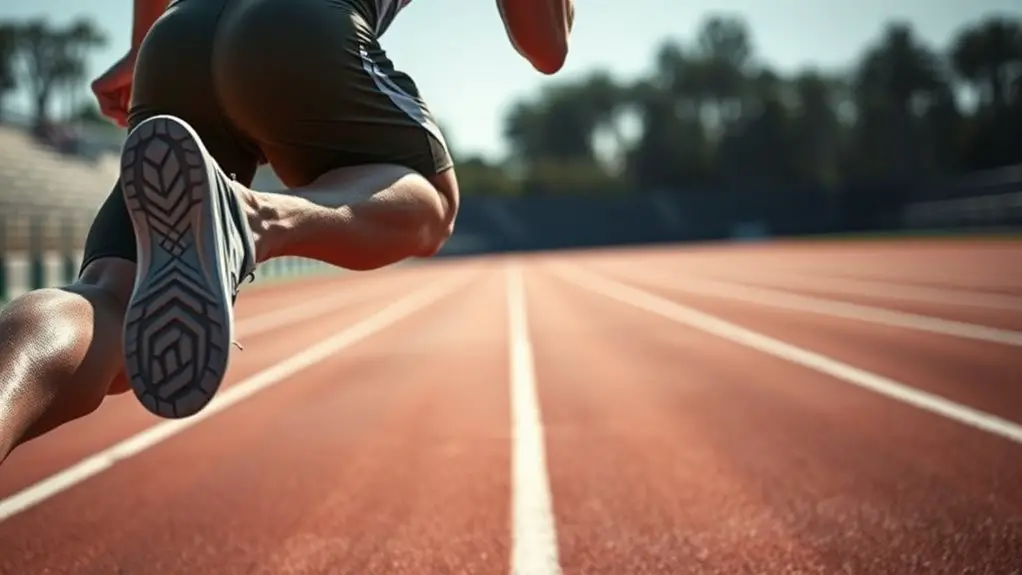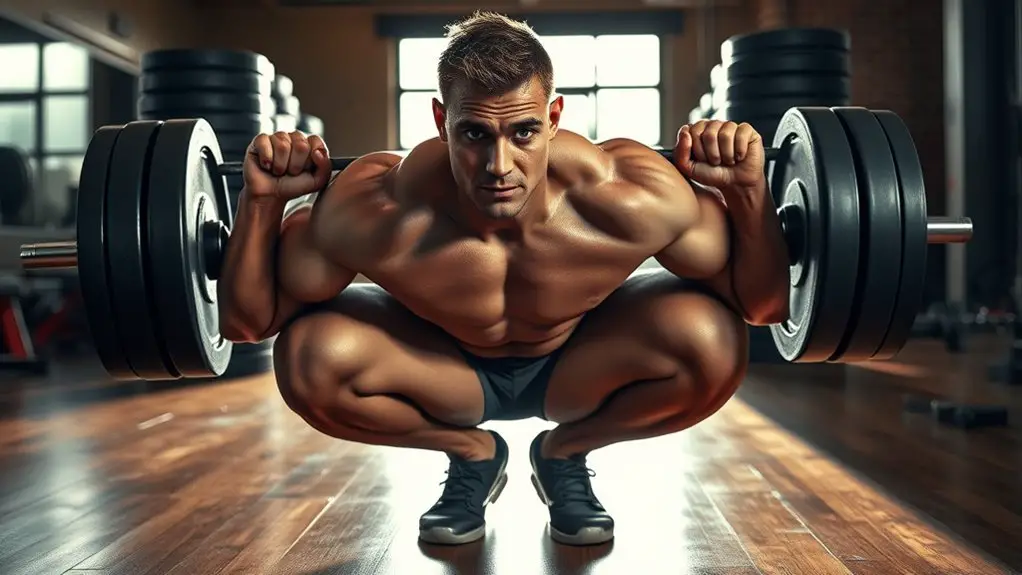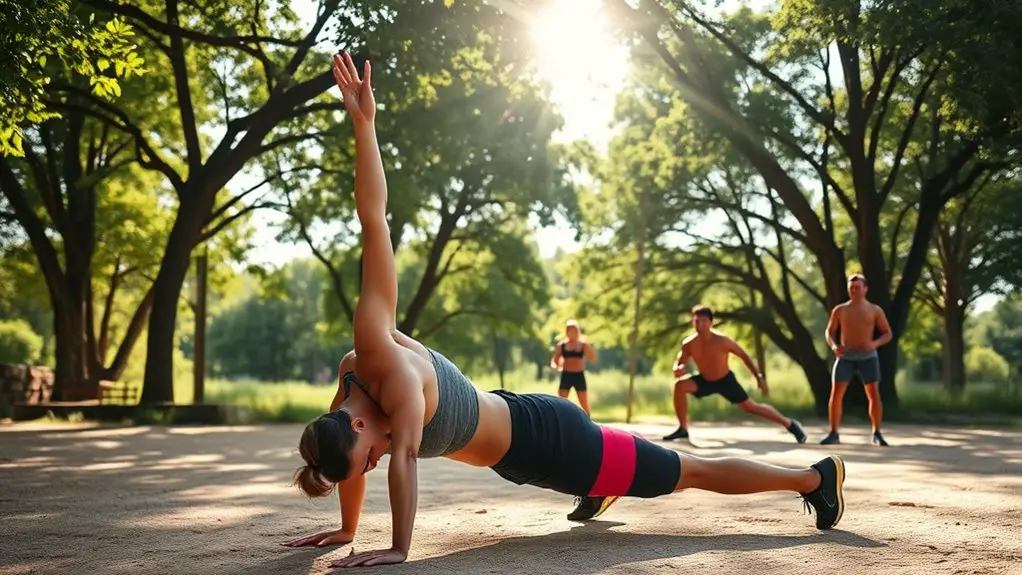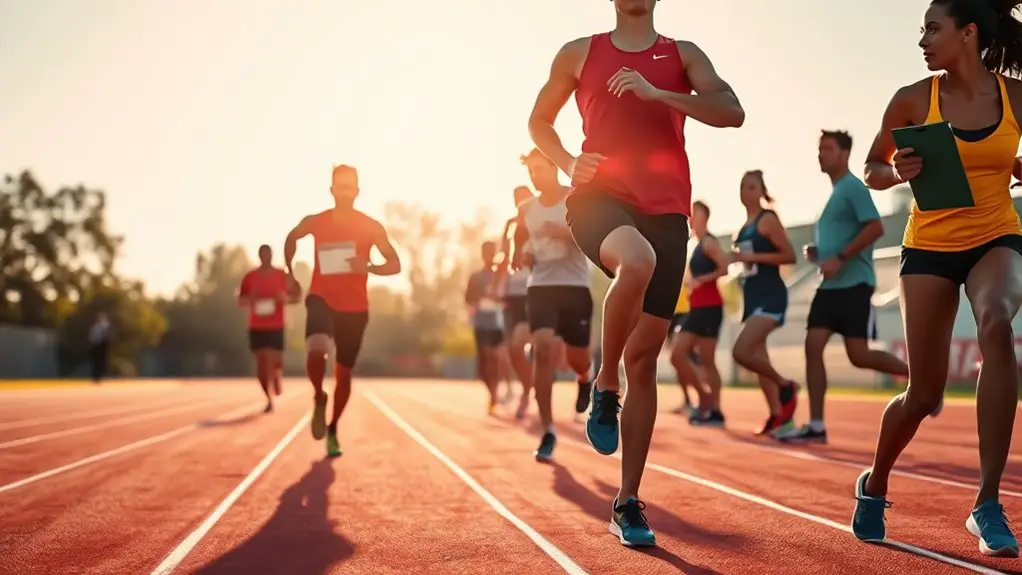The posterior chain, which includes your glutes, hamstrings, and lower back, is essential for athletic power. By optimizing strength and stability, it improves your explosiveness and movement efficiency, making you faster and more agile. Proper engagement of these muscles helps prevent injuries and enhances overall performance. Remember, it's not just about lifting weights; incorporating effective exercises and recovery strategies is key to maximizing your gains. There's so much more to discover about training this important muscle group.
Understanding the Posterior Chain: Key Muscle Groups
The posterior chain is a powerhouse of muscle groups that play an essential role in athletic performance. Understanding this chain is key to revealing your potential. It includes your glutes, hamstrings, and lower back, all working together to provide strength and stability. One critical aspect is glute activation; if your glutes aren't firing properly, you might struggle with both power and injury prevention. Engaging these muscles during workouts not only enhances your strength but also improves your overall movement patterns.
Equally important is hamstring flexibility. Tight hamstrings can limit your range of motion, affecting your speed and agility. By incorporating dynamic stretches and strength training focused on these areas, you can enhance your athletic performance and feel more liberated in your movements. Embracing these elements of the posterior chain can lead to greater freedom in your athletic pursuits, allowing you to push boundaries and achieve new heights in your performance. Additionally, prioritizing glute activation exercises ensures that these important muscles are properly engaged, maximizing your training outcomes.
The Importance of the Posterior Chain in Athletic Performance
Understanding the key muscle groups in the posterior chain sets the stage for appreciating their impact on athletic performance. These muscles, including the glutes, hamstrings, and lower back, play a critical role in posterior chain biomechanics, which directly influence how you generate power and speed. When you engage these muscles effectively, you release athletic performance benefits like improved explosiveness and stability.
Imagine sprinting down the track or jumping to make a play; the strength of your posterior chain fuels those movements. It's not just about raw power; it's about control and efficiency. A well-developed posterior chain helps you maintain proper posture, reduces the risk of injury, and enhances your overall athletic ability. Additionally, a strong core is essential for connecting the upper and lower body, allowing for optimal force transfer during explosive movements.
Common Mistakes in Training the Posterior Chain
While training the posterior chain is essential for athletic performance, many athletes make common mistakes that can hinder their progress. One major issue is poor form during exercises. When you rush through movements or don't focus on proper technique, you risk injury and limit gains. Remember, quality trumps quantity every time.
Another mistake is neglecting recovery. You might think pushing harder will yield better results, but your muscles need time to repair and grow stronger. Failing to incorporate rest days or adequate recovery methods can lead to burnout and decreased performance. Rest days are vital for recovery, rebuilding, and strength gain.
To achieve true freedom in your training, listen to your body. Prioritize good form, respect the need for recovery, and you'll unleash your posterior chain's full potential. Embrace these adjustments, and you'll find your strength and power will soar, enhancing your overall athletic performance.
Effective Exercises for Developing Posterior Chain Strength
To effectively develop posterior chain strength, incorporating a variety of targeted exercises is essential. Start with deadlift variations, like sumo and Romanian deadlifts, as they engage your glutes and hamstrings profoundly. These movements not only build strength but also enhance your overall athletic power.
Don't forget about glute activation; exercises like hip thrusts and glute bridges are fantastic for firing up those muscles. You can also add kettlebell swings to the mix, which provide dynamic movement while emphasizing hip extension. Incorporating resistance bands for exercises like banded good mornings can further enhance your glute activation. Additionally, focusing on posterior chain development through these exercises not only improves strength but also aids in injury prevention. Remember, variety keeps your workouts exciting and effective. By focusing on these exercises, you'll develop a strong posterior chain that supports your athletic performance and gives you the freedom to move more explosively. Embrace the challenge, and your body will thank you!
Integrating Posterior Chain Training Into Your Routine
Integrating posterior chain training into your routine can elevate your athletic performance considerably, especially when you strategically place these exercises within your weekly workouts. By focusing on your posterior chain, you'll unleash powerful movements that can enhance your overall strength and agility.
Elevate your athletic performance by integrating posterior chain training into your weekly workouts for enhanced strength and agility.
To make the most of your training frequency, consider these key tips:
- Schedule Consistency: Aim for 2-3 sessions per week dedicated to posterior chain work.
- Variety of Exercises: Incorporate a mix of deadlifts, kettlebell swings, and glute bridges to keep things fresh.
- Recovery Matters: Allow for adequate rest between sessions to promote muscle growth and prevent injury.
Additionally, compound movements like squats and deadlifts not only target the posterior chain but also improve overall strength and coordination. Embracing this approach not only strengthens your posterior chain but also empowers your athletic journey. By making these workouts a priority, you'll experience the freedom to move better and perform at your peak.
Frequently Asked Questions
How Does Age Affect Posterior Chain Strength and Performance?
As you age, you might notice an age-related decline in your posterior chain strength, which can impact your overall performance. It's crucial to adapt your training to maintain strength adaptations despite this decline. Incorporating exercises targeting these muscles can help combat the effects of aging. Remember, it's about finding a balance that keeps you feeling free and capable, allowing you to enjoy movement without limitations, no matter your age.
Can Injuries Impact the Effectiveness of Posterior Chain Training?
Injuries can definitely impact the effectiveness of your posterior chain training. If you're dealing with an injury, it's essential to focus on rehabilitation strategies that promote healing and prevent further issues. You might need to adjust your workout routine to accommodate your injury, ensuring you're still targeting those key muscles without overexerting yourself. Prioritizing injury prevention during your training can help you maintain strength and performance while allowing for a smoother recovery.
What Are the Best Recovery Methods for Posterior Chain Workouts?
Picture yourself after a tough workout, muscles aching but invigorated. To recover effectively, consider foam rolling to release muscle tension and improve blood flow. Pair that with active recovery, like light jogging or yoga, to keep your body moving without overexerting yourself. These methods not only help reduce soreness but also promote flexibility and strength. Embrace this freedom in your routine, allowing your body to heal while still enjoying movement.
How Does Nutrition Influence Posterior Chain Muscle Development?
Nutrition plays an essential role in developing your posterior chain muscles. Focusing on protein timing can optimize muscle recovery and growth, so try to consume protein shortly after workouts. Additionally, prioritize nutrient density in your meals; foods rich in vitamins and minerals support overall health and muscle function. By fueling your body with the right nutrients, you'll enhance your performance and feel more free to push your limits in your workouts.
Is There a Difference Between Male and Female Posterior Chain Training Needs?
You might think training needs are the same for everyone, but what if I told you there's more beneath the surface? Gender differences can greatly affect how your body adapts to training. Men typically have higher muscle mass and testosterone, leading to different adaptations than women. Understanding these distinctions can help you tailor your workouts for best results, ultimately giving you the freedom to release your true potential in the gym and beyond.




